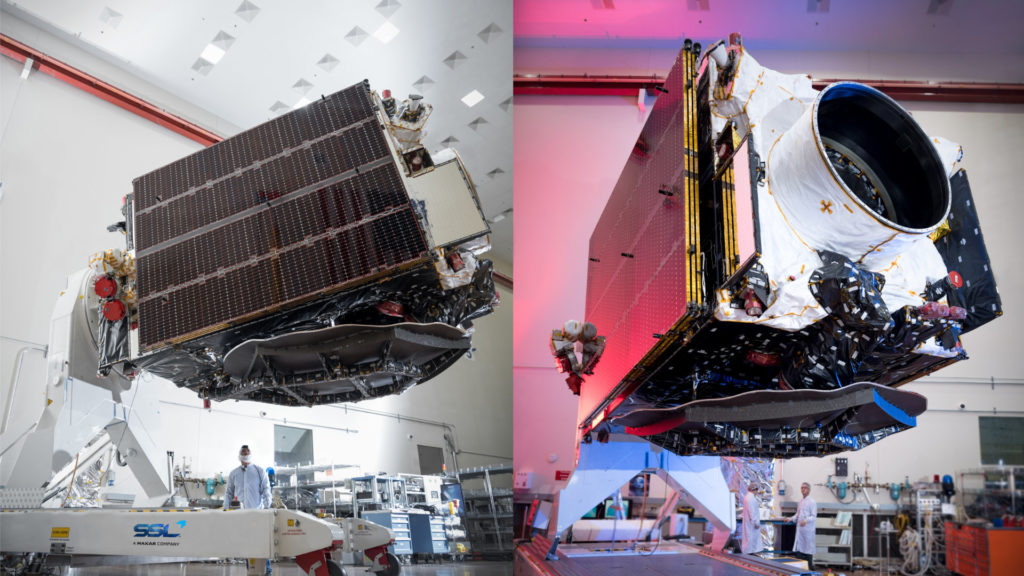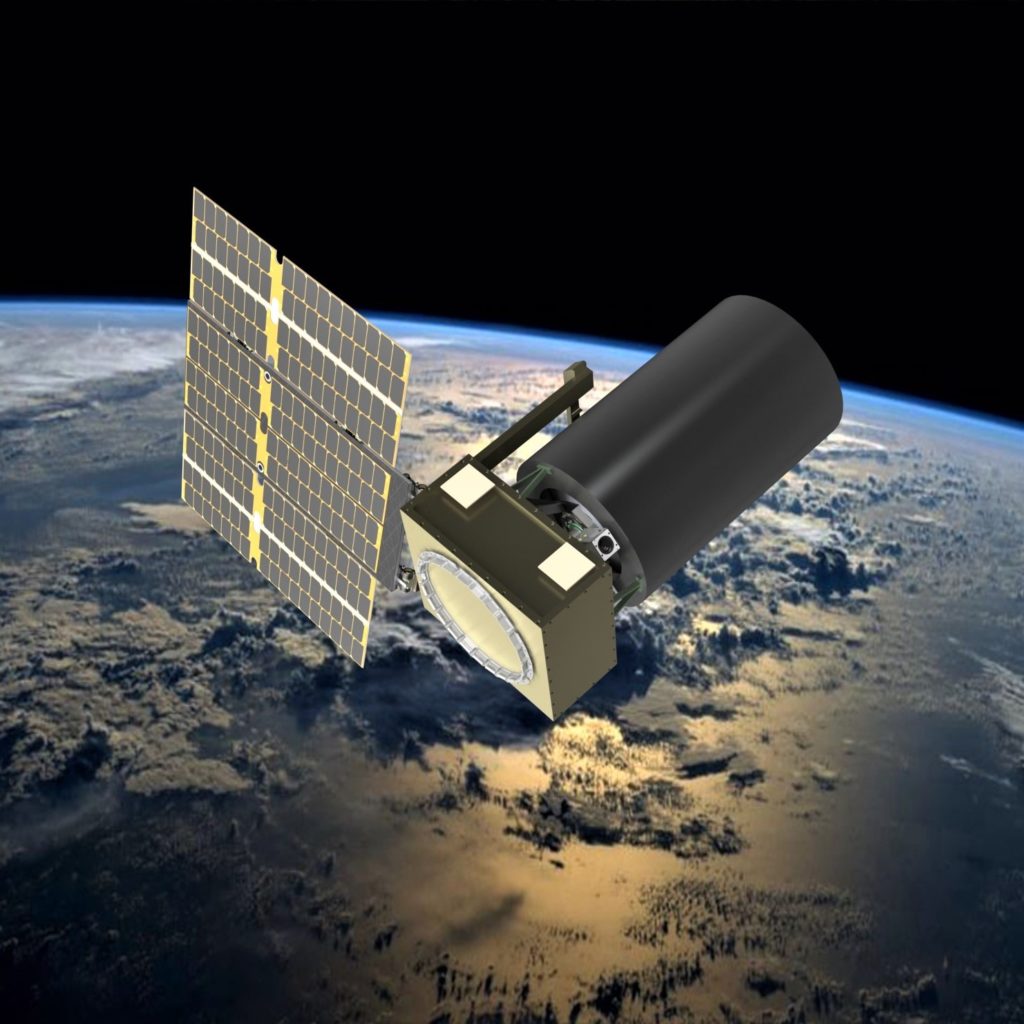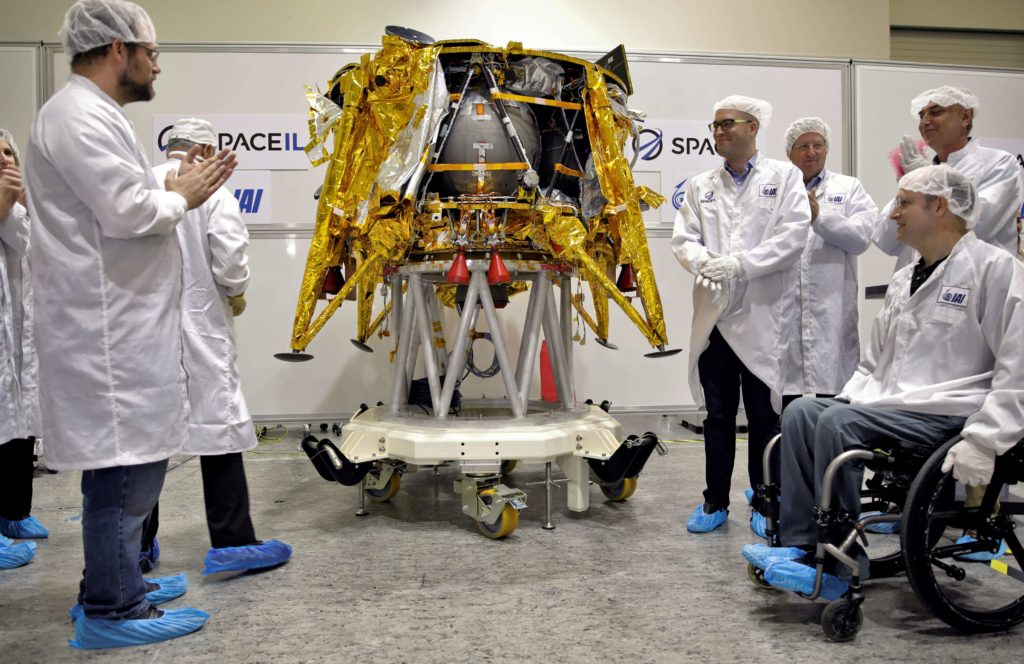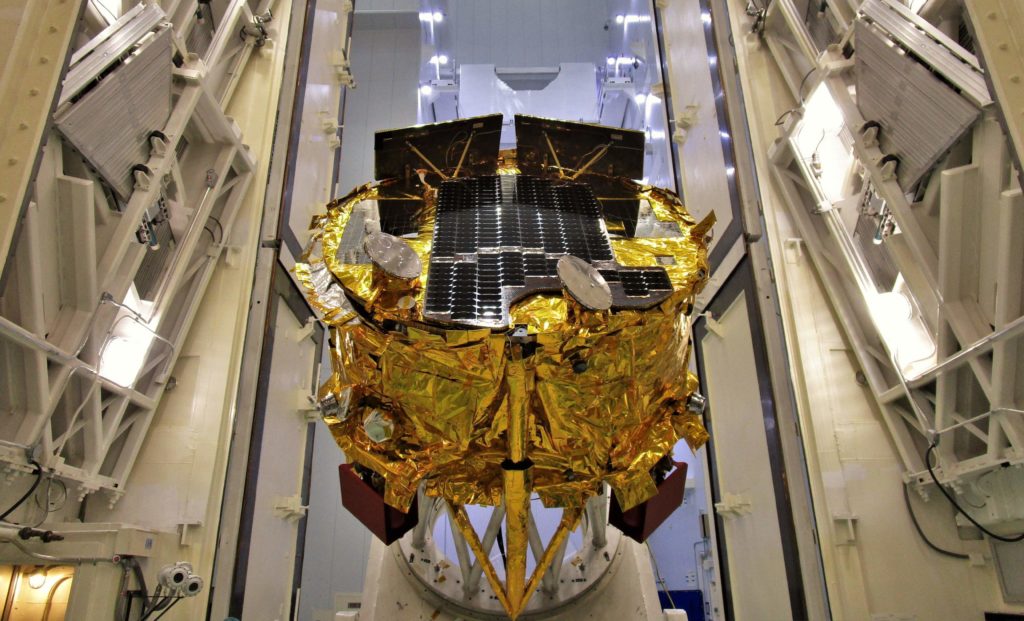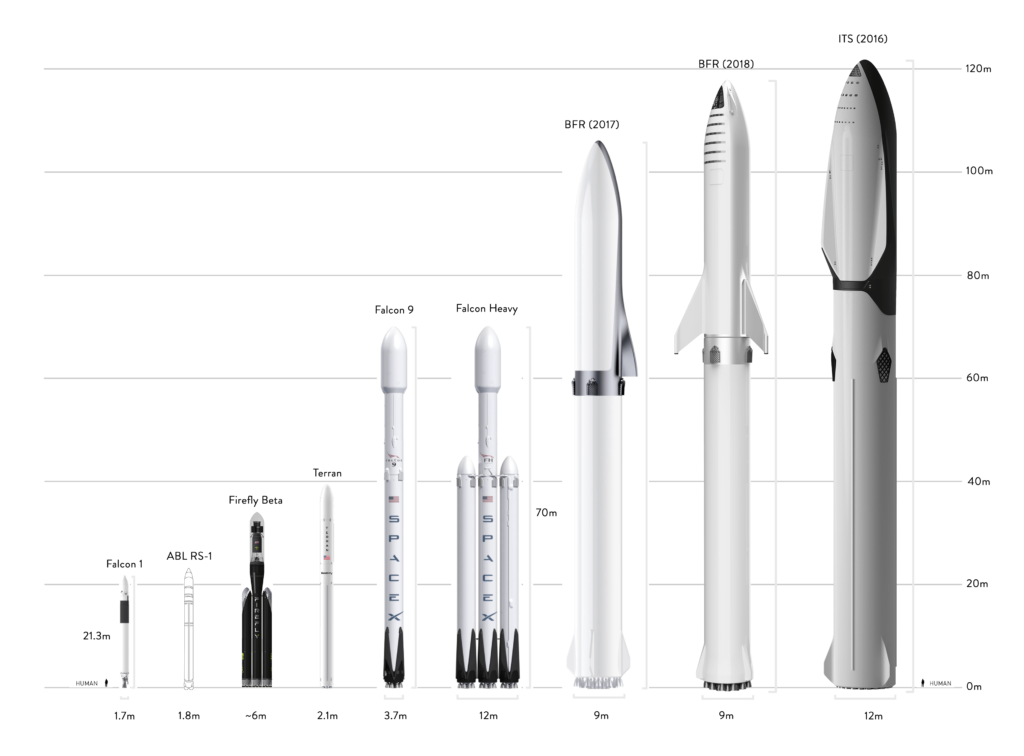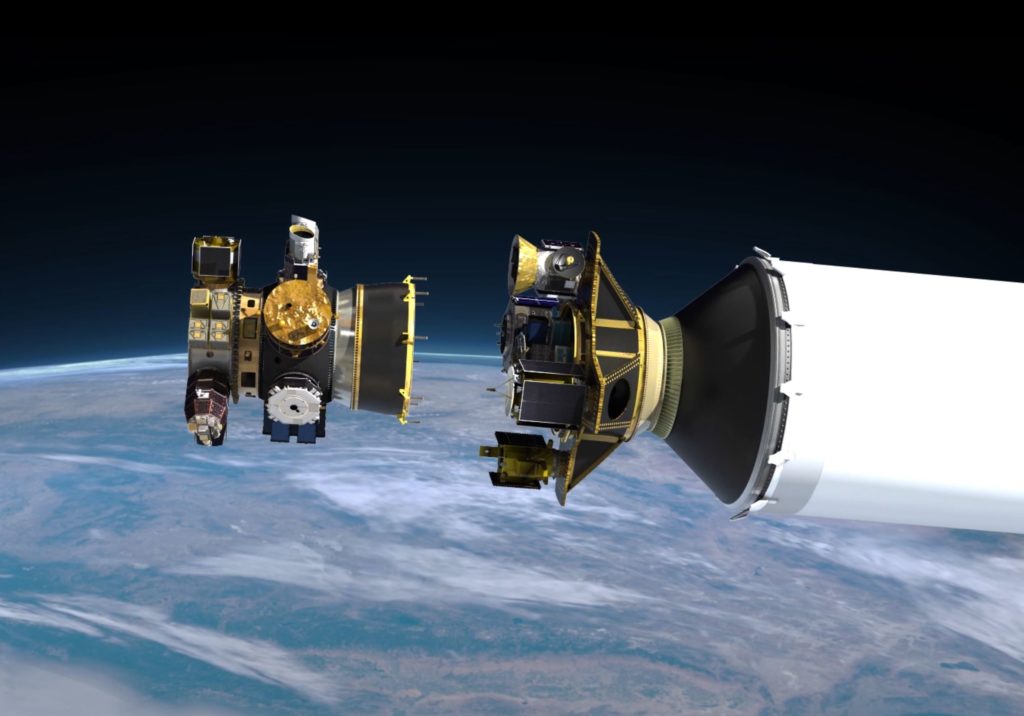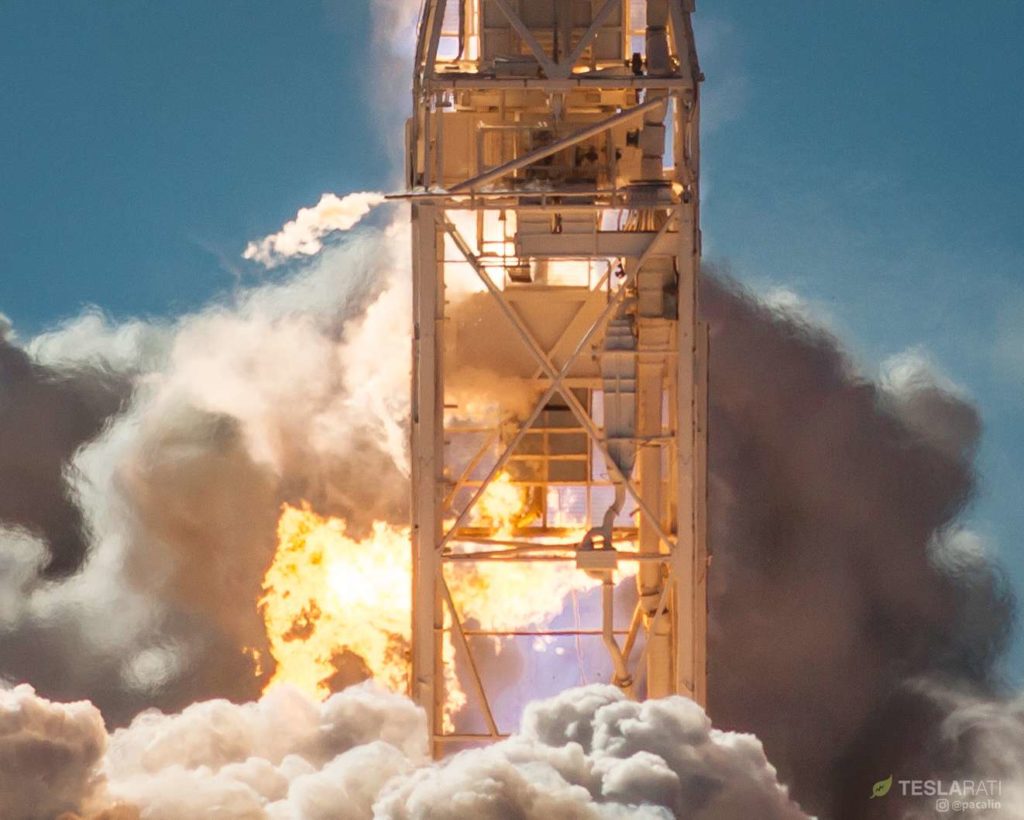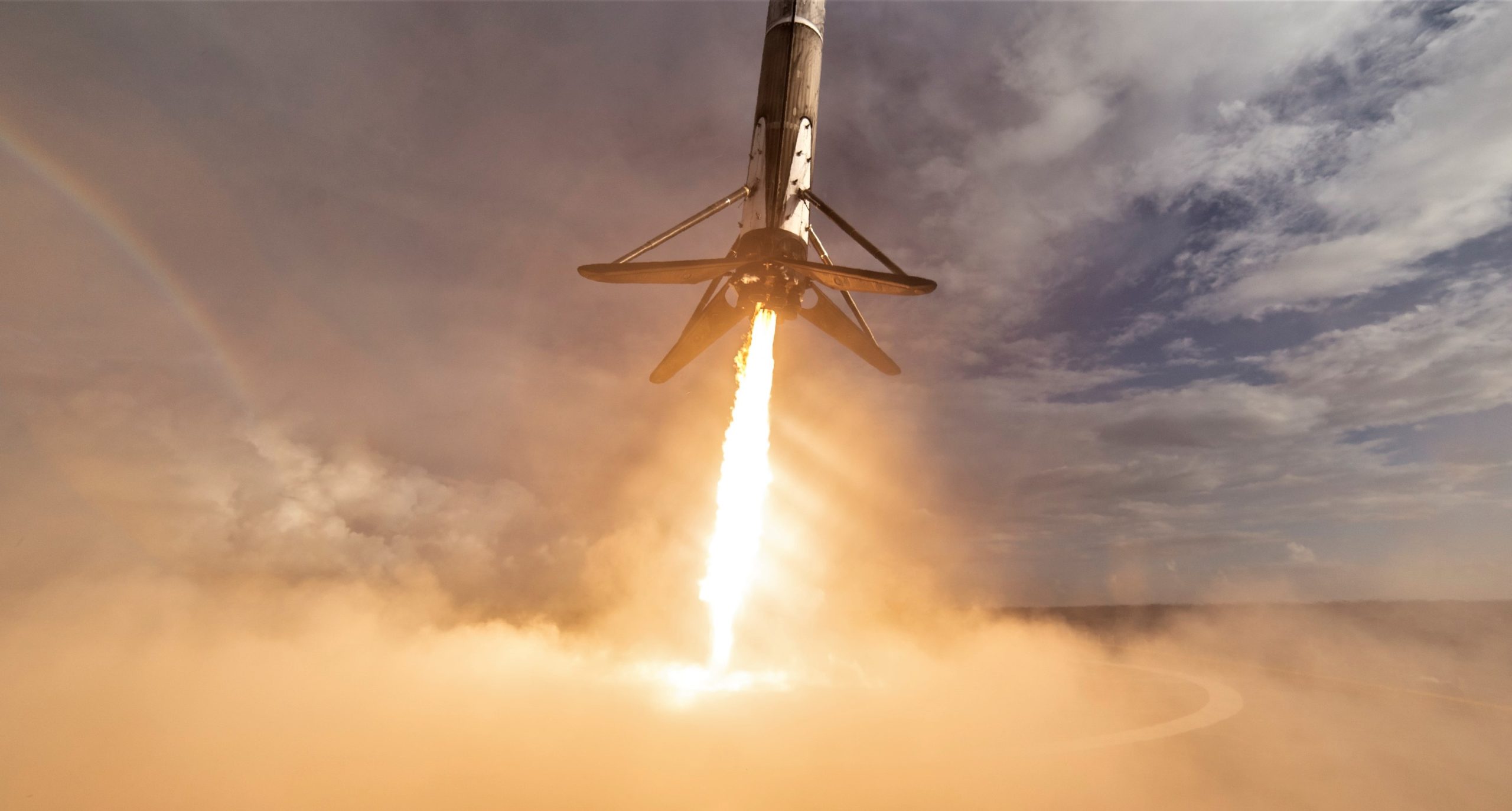
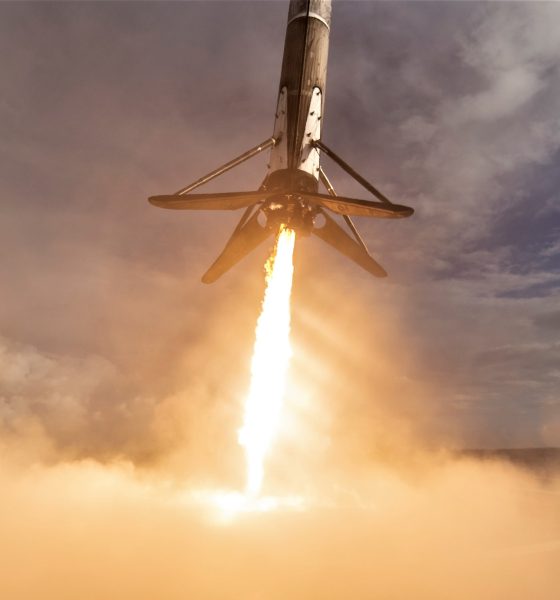
SpaceX
SpaceX test fires twice-flown Falcon 9 for world’s first commercial Moon mission
Likely to be the third orbital-class launch for the booster in question, SpaceX’s next launch – led by primary customer Pasifik Satelit Nusantara (PSN) – has the potential to lay claim to multiple major spaceflight “firsts”, ranging from the first time a twice-flown Falcon 9 has launched on the East Coast to the world’s first attempt to land a commercial spacecraft on another planetary body – the Moon, in this case.
SpaceX has completed the final critical test milestone of the mission’s flight-proven Falcon 9, filling the rocket with propellant and successfully static firing the booster on the evening of February 18th. According to SpaceX, all remains on schedule for a February 21st launch attempt from Cape Canaveral Air Force Station (CCAFS) Launch Complex 40 (LC-40), with liftoff currently targeted for 8:45 pm EDT (01:45 UTC).
Static fire test of Falcon 9 complete—targeting February 21 launch of Nusantara Satu from Pad 40 in Florida.
— SpaceX (@SpaceX) February 19, 2019
If all goes well, the launch of PSN satellite Nusantara Satu (formerly PSN-6; translation: “One Archipelago”) – carrying two copassenger spacecraft – could be an immensely significant moment for commercial spaceflight. Thanks to the support of rideshare provider Spaceflight Industries, those two passengers will be sent to high-energy geostationary orbits long relegated to dedicated launches of extremely large satellites, typically weighing multiple tons. While one could fairly argue that this is not the first time in history that a geostationary rideshare launch has occurred, it is almost certainly the first time that such a mission profile has been attempting for a commercial customer.
We are going to the moon! A 3D engine mount from RUAG Space will be the first 3D printed part on the moon. Our 3D part will support landing and lift off of Lunar Lander from @TeamSpaceIL. Congrats to our incredible engineers! pic.twitter.com/AbFZFD7GPB
— Peter Guggenbach (@PeterGuggenbach) February 11, 2019
In this case, that commercial entity is the Israeli company SpaceIL in support of the world’s first commercially-developed Moon lander, a ~600 kg (1300 lb) spacecraft known as Beresheet (Hebrew for “In the beginning”). Designed by SpaceIL and constructed by Israel Aerospace Industries (IAI), the craft has since been installed atop PSN-6 and encased in Falcon 9’s payload fairing along with one much smaller copassenger, an Air Force Research Laboratory-funded (AFRL) microsat known as “S5”. The latter spacecraft weighs roughly 60 kg (130 lb) and is an experiment designed to determine whether small satellites can be used in geostationary orbit (GEO), with S5 focusing on cataloging and tracking GEOsats.
- PSN-6, an SSL-built communications satellite weighing several thousand kilograms, arrived in Florida roughly 10 days ago. (SSL)
- The Air Force Research Lab’s S5 smallsat. (Blue Canyon)
- Beresheet is seen here prior to the spacecraft’s flight from Israel to Florida. (SpaceIL/IAI)
- After arriving in Florida, Spaceflight was tasked with integrating Beresheet with PSN-6. (SpaceIL/Spaceflight)
Spaceflight Industries aims for new market creation
Shepherded by rideshare industry leader Spaceflight, the PSN-6 rideshare – known by the company as GTO-1 – has the potential to open up a new and highly useful realm of spaceflight previously all but closed off to customers lacking tens of millions of dollars for launch costs. While it’s unclear how exactly Spaceflight worked with SSL and/or PSN to make it happen, the mission profile and its potential are both fascinating and complex.
“What we’re doing with [GTO-1] is really cool, cause this is a type of mission that hasn’t really been available [commercially] in the past – taking a ride all the way to GEO and then separating in GEO as an independent spacecraft . . . We’re really excited about testing the market and proving – really, making – a new market here with the GEO [and GTO] rideshare.” – Ryan Olcott, Spaceflight (Jan. 2019)
In a late-January interview with Spaceflight’s Mission Director Ryan Olcott, the senior manager was audibly excited about the future potential of Spaceflight’s new GTO (and GEO) offerings and the many ways that they could change the game for a number of companies and startups with far smaller but no less capable spacecraft. Including startups Astranis and Terran Orbital and industry stalwart SSL, interest in small geostationary satellites has never been higher, and a number of pathfinder missions in 2020 and 2021 – if successful or at least promising – could mark a paradigm shift for the geostationary satellite communications industry as a whole. Often sized perfectly (100-500 kg) for a handful of in-development smallsat launch vehicles like Relativity’s Terran, Firefly’s Beta, and ABL Space’s RS-1, it will likely be several years before those new rockets are capable of reliably supporting these much smaller launches, leaving rideshare missions as the only real route for interested customers until the early to mid 2020s.
- Astranis’ “MicroGEO” offering compared beside one of the largest geostationary satellite buses. (Astranis)
- The change in scale between ITS, BFR, and BFR 2018 is significant. (Teslarati)
- A render of Spaceflight’s SSO-A dispensers attached to Falcon 9’s second stage.
- Falcon 9 B1046 lifts off for the third time with Spaceflight’s SSO-A rideshare mission. (Pauline Acalin)
In the process of undertaking this milestone geostationary rideshare, Spaceflight had to design, build, and test custom hardware needed to protect the AFRL’s S5 spacecraft on its multi-week ridealong from geostationary transfer orbit to PSN-6’s geostationary orbit destination, as well as unique mounting hardware needed to load SpaceIL’s Beresheet spacecraft atop the main satellite host. In fact, GTO-1’s mission profile is impressively complex, requiring multiple mission-specific maneuvers and separation events to detach Beresheet shortly after the entourage separates from Falcon 9, carry S5 to a geostationary graveyard orbit (GEO + ~300 km) to separate Spaceflight’s custom hardware, return to a lower orbit to deploy the Air Force satellite, and finally insert PSN-6 into its final operational orbit.
“We actually have to open up our adapter system to allow the [AFRL S5] spacecraft to come out, so we have about a half-day time window that we’re aiming for where we will separate the top off of our cone adapter system and then drop [the orbit] back down a little bit [because we can’t drop that junk off in GEO – you have to use the GEO graveyard slot].” – Ryan Olcott, Spaceflight

“GTO is pretty cool because you can do all sorts of positive C3 missions [to] Lagrange points or just about [anywhere] in the solar system you want to go to … With SpaceIL, potentially in the future [Spaceflight will also] be able to partner with them to bring things to the Moon if they’ve got customers that want to bring payloads to the Moon.” – Ryan Olcott, Spaceflight
The fact that the first primary passenger (by weight) of GTO-1 is a mission as groundbreaking as the commercial Beresheet Moon lander is also by no means a coincidence according to Ostello, a feeling that was rapidly backed up by an agreement between IAI and European company OHB to potentially use Beresheet-derived landers to deliver European payloads to the Moon. Ostello expressed a similar interest and optimism a few weeks prior to that announcement. While not directly involving Spaceflight, the fact that IAI (Beresheet’s manufacturer) is interested in producing more landers for other customers essentially opens the door for Spaceflight or other commercial or governmental entities to purchase future landers for customer payloads or arrange their launch to the Moon.
Second time’s the third-time charm
Set to launch on an unspecified Falcon 9, process of elimination (i.e. which boosters are in Florida) implies that PSN-6/GTO-1 will feature either Falcon 9 booster B1047 or B1048, two flight-proven boosters with no know missions assigned that are also known to be in Cape Canaveral. B1047 last launched the Es’hail-2 satellite in mid-November, while B1048 completed its second launch (from California) in early October before shipping to Florida for unknown reasons. With B1048 situated in 39A’s hangar, the lack of any reports of a booster moving from 39A to 40 suggest that B1047 was the Falcon 9 that successfully conducted its third on-pad static fire last night.
Shortly after launch, the Falcon 9 booster will make its way to drone ship Of Course I Still Love You (OCISLY) – located ~650 km (400 mi) off the coast of Florida – for what will be the second time ever that SpaceX has successfully launched and landed the same Falcon 9 booster three times, following on the heels of B1046’s third launch last December. SpaceX fairing recovery vessel Mr. Steven also arrived at Port Canaveral last week after a nearly 8000 km (5000 mi) journey from Port of Los Angeles, raising the possibility of his first attempt at a fairing catch on the East Coast.

Check out Teslarati’s newsletters for prompt updates, on-the-ground perspectives, and unique glimpses of SpaceX’s rocket launch and recovery processes!

News
SpaceX reportedly mulling IPO, eyeing largest of all time: report
“I do want to try to figure out some way for Tesla shareholders to participate in SpaceX. I’ve been giving a lot of thought to how to give people access to SpaceX stock,” Musk said.
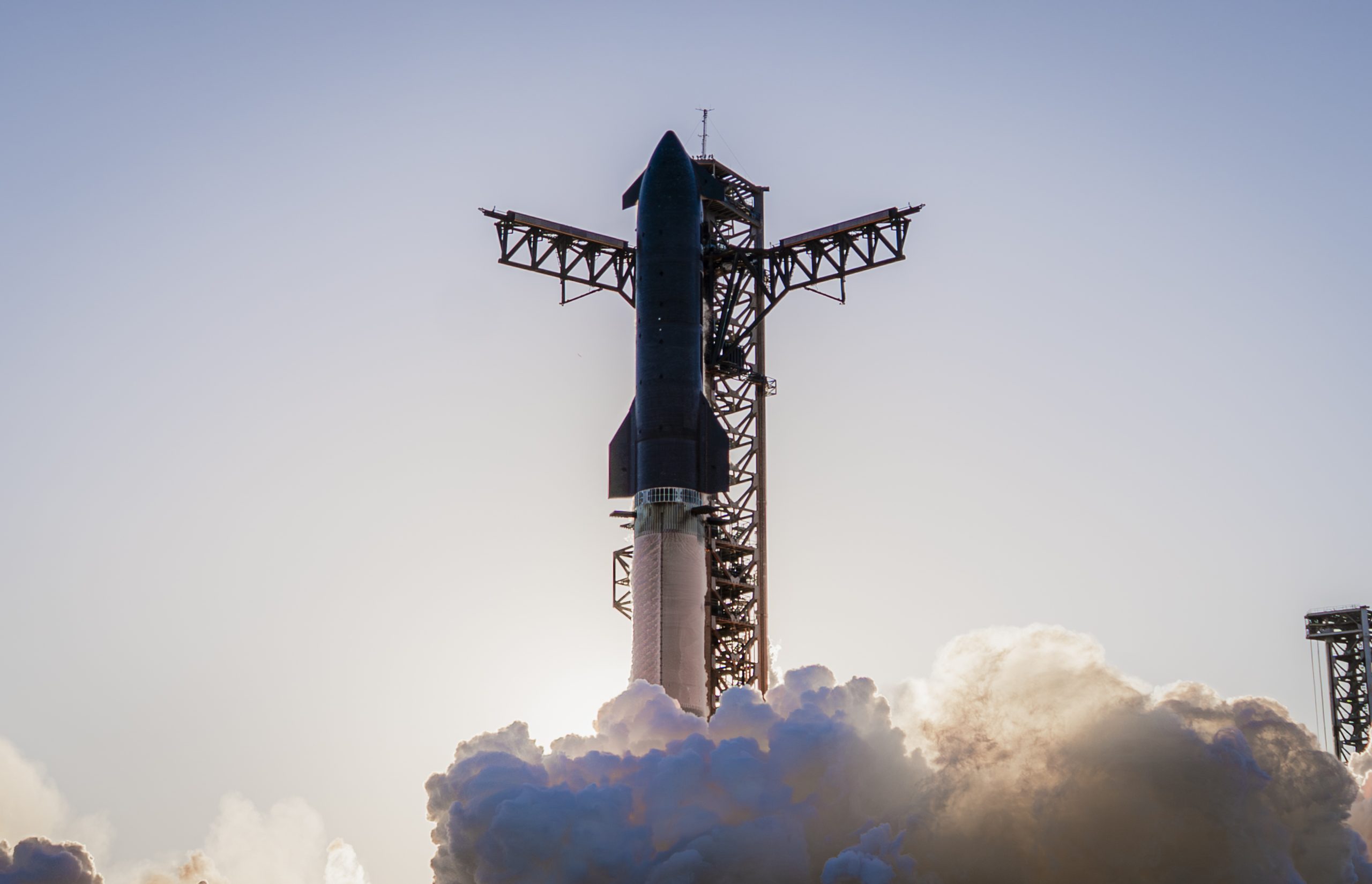
SpaceX is reportedly mulling an initial public offering, eyeing what would be the largest valuation at the time of availability of all time, a new report from Bloomberg said on Tuesday.
It is one of many reports involving one of Elon Musk’s companies and a massive market move, as this is not the first time we have seen reports of an IPO by SpaceX. Musk himself has also dispelled other reports in the past of a similar nature, including an xAI funding round.
SpaceX and Musk have yet to comment on the report. In the past, untrue reports were promptly replied to by the CEO; this has not yet gained any response, which is a good sign in terms of credibility.
However, he said just a few days ago that stories of this nature are inaccurate:
“There has been a lot of press claiming SpaceX is raising money at $800B, which is not accurate. SpaceX has been cash flow positive for many years and does periodic stock buybacks twice a year to provide liquidity for employees and investors. Valuation increments are a function of progress with Starship and Starlink and securing global direct-to-cell spectrum that greatly increases our addressable market. And one other thing that is arguably most significant by far.”
There has been a lot of press claiming @SpaceX is raising money at $800B, which is not accurate.
SpaceX has been cash flow positive for many years and does periodic stock buybacks twice a year to provide liquidity for employees and investors.
Valuation increments are a…
— Elon Musk (@elonmusk) December 6, 2025
Musk has discussed a potential IPO for SpaceX in recent months, as the November 6 shareholder meeting, as he commented on the “downsides” of having a public company, like litigation exposure, quarterly reporting pressures, and other inconveniences.
Nevertheless, Musk has also said he wants there to be a way for Tesla shareholders to get in on the action. At the meeting in early November, he said:
“I do want to try to figure out some way for Tesla shareholders to participate in SpaceX. I’ve been giving a lot of thought to how to give people access to SpaceX stock.”
Additionally, he added:
“Maybe at some point., SpaceX should become a public company despite all the downsides of being public.”
Musk has been historically reluctant to take SpaceX public, at times stating it could become a barrier to colonizing Mars. That does not mean it will not happen.
Bloomberg’s report cites multiple unidentified sources who are familiar with the matter. They indicate to the publication that SpaceX wants to go public in mid-to-late 2026, and it wants to raise $30 billion at a valuation of around $1.5 trillion.
This is not the first time SpaceX has discussed an IPO; we reported on it nine years ago. We hope it is true, as the community has spoken for a long time about having access to SpaceX stock. Legendary investor Ron Baron is one of the lucky few to be a SpaceX investor, and said it, along with Tesla, is a “lifetime investment.”
Tesla bull Ron Baron reveals $100M SpaceX investment, sees 3-5x return on TSLA
The primary driver of SpaceX’s value is Starlink, the company’s satellite internet service. Starlink contributes 60-70 percent of SpaceX’s revenue, meaning it is the primary value engine. Launch services, like Falcon 9 contracts, and the development of Starship, also play supporting roles.
News
SpaceX reaches incredible milestone with Starlink program
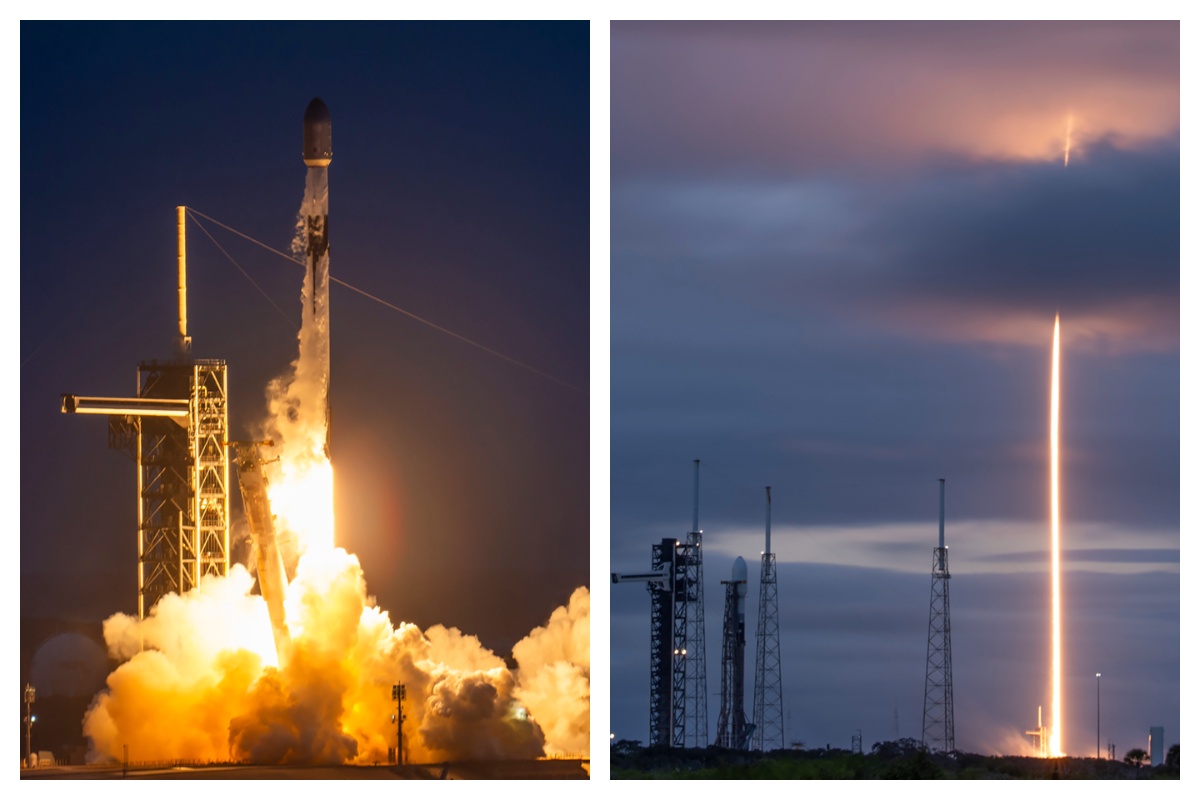
SpaceX reached an incredible milestone with its Starlink program with a launch last night, as the 3,000th satellite of the year was launched into low Earth orbit.
On Monday, SpaceX also achieved its 32nd flight with a single Falcon 9 rocket from NASA’s Kennedy Space Center.
The mission was Starlink 6-92, and it utilized the Falcon 9 B1067 for the 32nd time this year, the most-used Falcon booster. The flight delivered SpaceX’s 3000th Starlink satellite of the year, a massive achievement.
There were 29 Starlink satellites launched and deployed into LEO during this particular mission:
Falcon 9 launches 29 @Starlink satellites from Florida pic.twitter.com/utKrXjHzPN
— SpaceX (@SpaceX) December 9, 2025
SpaceX has a current goal of certifying its Falcon boosters for 40 missions apiece, according to Spaceflight Now.
The flight was the 350th orbital launch from the nearby SLC-40, and the 3,000 satellites that have been successfully launched this year continue to contribute to the company’s goal of having 12,000 satellites contributing to global internet coverage.
There are over five million users of Starlink, the latest data shows.
Following the launch and stage separation, the Falcon 9 booster completed its mission with a perfect landing on the ‘Just Read the Instructions’ droneship.
The mission was the 575th overall Falcon 9 launch, highlighting SpaceX’s operational tempo, which continues to be accelerated. The company averages two missions per week, and underscores CEO Elon Musk’s vision of a multi-planetary future, where reliable connectivity is crucial for remote work, education, and emergency response.
As Starlink expands and works toward that elusive and crucial 12,000 satellite goal, missions like 6-92 pave the way for innovations in telecommunications and enable more internet access to people across the globe.
With regulatory approvals in over 100 countries and millions of current subscribers, SpaceX continues to democratize space, proving that reusability is not just feasible, but it’s also revolutionary.
Elon Musk
Elon Musk gives nod to SpaceX’s massive, previously impossible feat
It was the booster’s 30th flight, a scenario that seemed impossible before SpaceX became a dominant force in spaceflight.

Elon Musk gave a nod to one of SpaceX’s most underrated feats today. Following the successful launch of the Transporter-15 mission, SpaceX seamlessly landed another Falcon 9 booster on a droneship in the middle of the ocean.
It was the booster’s 30th flight, a scenario that seemed impossible before SpaceX became a dominant force in spaceflight.
Elon Musk celebrates a veteran Falcon 9 booster’s feat
SpaceX completed another major milestone for its Smallsat Rideshare program on Friday, successfully launching and deploying 140 spacecraft aboard a Falcon 9 from Vandenberg Space Force Base. The mission, known as Transporter-15, lifted off two days later than planned after a scrub attributed to a ground systems issue, according to SpaceFlight Now. SpaceX confirmed that all payloads designed to separate from the rocket were deployed as planned.
The Falcon 9 used for this flight was booster B1071, one of SpaceX’s most heavily flown rockets. With its 30th mission completed, it becomes the second booster in SpaceX’s fleet to reach that milestone. B1071’s manifest includes five National Reconnaissance Office missions, NASA’s SWOT satellite, and several previous rideshare deployments, among others. Elon Musk celebrated the milestone on X, writing “30 flights of the same rocket!” in his post.
Skeptics once dismissed reusability as unfeasible
While rocket landings are routine for SpaceX today, that was not always the case. Industry veterans previously questioned whether reusable rockets could ever achieve meaningful cost savings or operational reliability, often citing the Space Shuttle’s partial reusability as evidence of failure.
In 2016, Orbital ATK’s Ben Goldberg argued during a panel that even if rockets could be reusable, they do not make a lot of sense. He took issue with Elon Musk’s claims at the time, Ars Technica reported, particularly when the SpaceX founder stated that fuel costs account for just a fraction of launch costs.
Goldberg noted that at most, studies showed only a 30% cost reduction for low-Earth orbit missions by using a reusable rocket. “You’re not going to get 100-fold. These numbers aren’t going to change by an order of magnitude. They’re just not. That’s the state of where we are today,” he said.
Former NASA official Dan Dumbacher, who oversaw the Space Launch System, expressed similar doubts in 2014, implying that if NASA couldn’t make full reusability viable, private firms like SpaceX faced steep odds.
